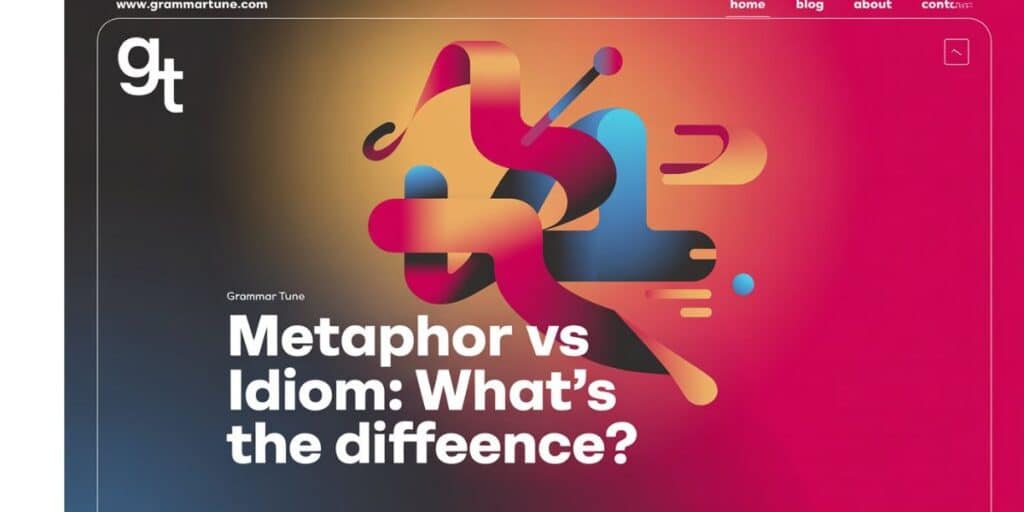Are there days you feel like you’ve been floating on air or drowning in paperwork? These colorful expressions are not only fun; they speak from the depths of metaphors and idioms.
This short guide briefly discusses the differences between metaphor and idiom. So now you can use either with both confidence and panache.
What is a Metaphor?
This word is a figure of speech in direct comparison that conveys some sense of one thing being another, some different real entity.
For example, when it is said that “time is a thief,” it suggests that time is stealing our moments, although time is not actually any thief. This comparison adds weight to the phrase and gives deeper insight or meaning in it.
Must Read: Letter or Alphabet: Understanding the Difference
Characteristics of Metaphors
Non-literal Comparison
In other words, “a lion in battle” compares the ferocity of a man against that of a lion.
Vivid Imagery
One thing must be translated into another for metaphors to become visual or sensory images that enhance the reader’s experience.
Explaining Complex Ideas
By making sources seem one with another, metaphors can often make vivid similes or sensory images enhancing reader experience.
Emphasizing Specific Qualities
Particular characteristics or aspects are mostly highlighted here and given more clarity.
Conciseness
Be able to convey complex ideas concisely and powerfully such as in the form of metaphors.
Increased Creativity
These promote finding new and imaginative ways to think and express ideas, resulting in richer and more interesting language use.
Must read about: Analogy vs Allegory: What’s the Difference?
What is an Idiom?
Means it’s that phrase that is understood not side by side by the ordinary meanings of its compose words. For example, the above expression: “kick the bucket” is interpreted as dying, not literally to kick a bucket.
Characteristics of Idioms:
Non-literal Meaning:
An idiom is a representation of the literal meaning of its words. Thus, take an example such as the expression, “break the ice.” This does not mean to break ice but rather to hold the first conversation in an assembly.
Cultural Context:
Philosophical idioms and sayings may involve a culture in their expression; therefore, they may be difficult for a foreigner to understand.
Expressiveness
Case in point, color and character are alternates in language. They often use a vivid way of conveying emotion or sentiment.
Ease of Understanding
When familiarized with an idiom, an interpretation of it is easily attained and the idiom used accordingly.
Enhancing Communication
Idioms have the capability to make discussions much more interesting or relatable, especially in informal situations.
Consistency
An idiom is that its meaning is fixed no matter in whatever context.
Metaphor vs Idiom: The Differences
| Aspect | Metaphor | Idiom |
| Definition | A direct comparison between two unlike things. | A phrase with a meaning not deducible from its words. |
| Literal vs Figurative | Involves a non-literal comparison. | Has a figurative meaning separate from the literal words. |
| Creativity vs Convention | Often used creatively to describe something in a novel way. | Relies on established phrases within a language community. |
| Flexibility | Flexible; can be adapted or modified. | Fixed; altering the words often changes the meaning. |
| Understandig | Can often be understood through the implied comparison. | Requires familiarity with the idiom’s meaning. |
| Purpose | Aims to express an idea more vividly. | Provides a concise, culturally embedded way to express an idea. |
How to Use Metaphors and Idioms Effectively?
To use metaphors and idioms effectively:
- Know Your Audience: Ensure that your audience understands the metaphor or idiom. What works in one culture or context may not work in another.
- Use Them Sparingly:Using too many metaphors can make your writing sound cliché.
- Be Clear: While metaphors and idioms are an embellishment, always keep in mind that your message should be clear and understood.
- Choose Appropriate Contexts:Some metaphors and idioms may fit better in informal writing or speech, while others are suitable for formal use.
Examples of Metaphors and Idioms
Examples of Metaphors
Thus, the figure of speech known as stage simile would describe life as a play where people go on performing their roles.
Therefore, the idea here revolves around the aphorism of time like a bandit who thieves time away since it is second to none.
He is an illustration of a heart made of stone that symbolizes somebody who is cold and miserable inside.
Examples of Idioms
“Open the conversation.” In social contexts, bring someone into a discussion with others.
The to kick the bucket.” To die.
They to spill the beans.” To tell or reveal a secret.
Here Are Some Common Metaphors You Might Want to Use:
“A sea of troubles” – The trouble galore.
“A tide of emotions” – The tide of emotions.
“A mountain of issues” – A whole load of issues.
Origins of Metaphors and Idioms
Metaphor
From the ancient Greek word “metaphora,” means “to transfer, to carry over,” which is actually a good starting point. It denotes the carrying of meaning from one idea or concept to another, thereby establishing a kind of likeness in comparison between two essentially different things.
Idiom
At times the origin of an idiom is unknown; but many do have historical roots or some connection to cultural practices or widely known traditional sayings.
For example, “kick the bucket” is believed to come from a method of slaughter in which, when the animal is treated, a bucket is kicked as an act of slaughtering. Contextual consanguinity of this sort makes for the understanding of the meaning and the use of a metaphor or idiom.
You will be must like about: Letter or Alphabet: Understanding the Difference
Conclusion
To understand the distinction between metamorphic and idiomatic expressions is to be able to use language with more creative efficiency.
Both add an interesting flavor and depth but while on one hand a metaphor compares unrelated things to suggest meaning; on the other an idiom involves a fixed expression which is tied to the culture and it has non-literal consequences attached to it.
Mastering the use of both adds richness to writing as well as honing the sharpening communication and an even more memorable mentioning of ideas. The next time you articulate yourself: ponder if a metaphor or an idiom is what you really want to communicate-the difference can be stark.
FAQ,S
What’s the main difference between a metaphor and an idiom?
A metaphor compares two things directly; an idiom has a fixed, non-literal meaning.
Can idioms be translated into other languages?
Not always—idioms are often culture-specific and may lose meaning when translated.
Are metaphors always obvious?
No, some are subtle and require interpretation based on context.
Do idioms change over time?
Rarely—idioms are usually fixed phrases passed down through usage.
Can I use metaphors and idioms in formal writing?
Yes, but use them sparingly and ensure they’re appropriate for the tone.

Joulia, a seasoned wordsmith and grammar enthusiast, brings over a decade of blogging expertise to Grammar Tune. With a keen eye for linguistic precision and a passion for making complex grammar concepts accessible, he has helped thousands of readers enhance their writing skills. His engaging teaching style and practical approach to language learning have made him a trusted voice in the online grammar community.







